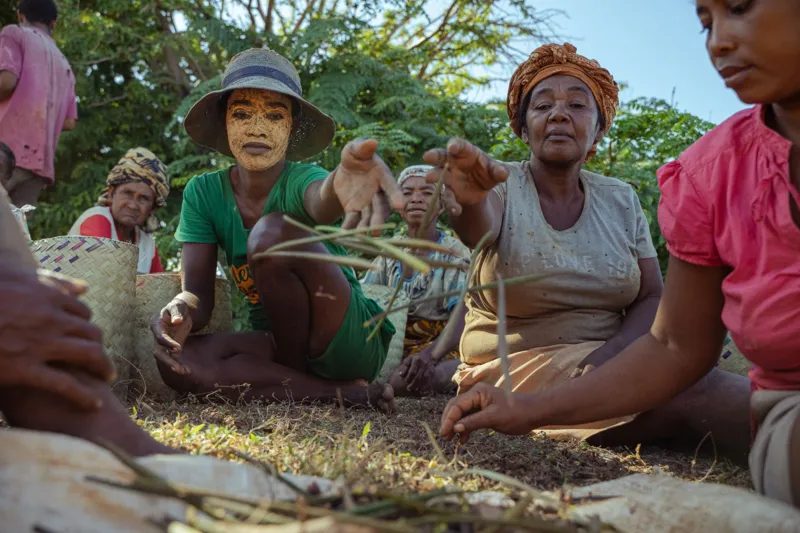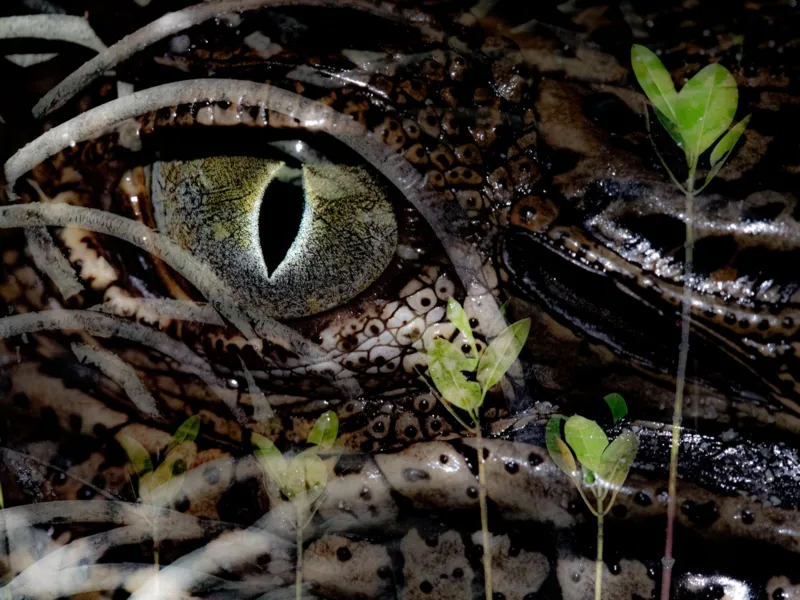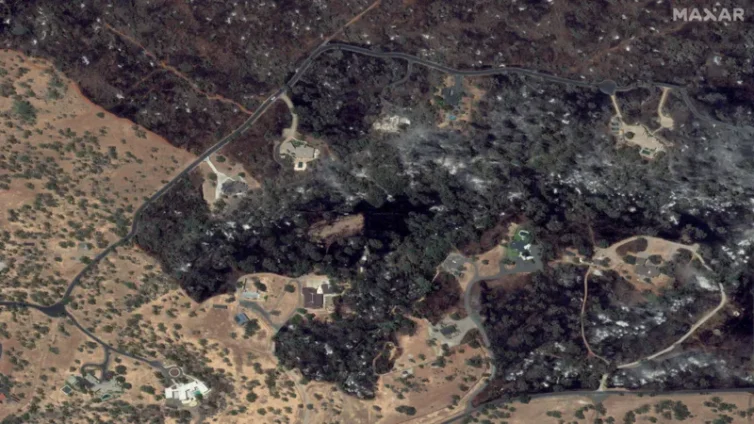Supratim Bhattacharjee has been named overall winner of this year's Mangrove Photography Awards for his image of a young girl in the aftermath of a devastating storm in Frazerganj, Sundarbans, India.

Run by the Mangrove Action Project, the competition - now in its 10th year - aims to show the relationships between wildlife, coastal communities and mangrove forests, as well as the fragility of these unique ecosystems, both above and below the waterline.
Mr Bhattacharjee's winning image, called Sinking Sundarbans, shows Pallavi standing in front of her home and tea shop, which has been destroyed by the sea during a storm.
"I observed her strong face and calm nature during that devastating period," said Mr Bhattacharjee.
"Children are the ones that suffer the most."
Nestled in the Bay of Bengal, the Sundarbans is the largest mangrove forest in the world.
"[The winning] image raises a thousand questions, whilst connecting you to the girl's heart," said competition judge Dhritiman Mukherjee.
"Her vulnerability exposes the full impact of climate change and sea level rise experienced by many coastal communities.”
Mangroves are an important protection against climate change, with one acre (4,000sq m) of mangrove forest absorbing nearly the same amount of carbon dioxide as an acre of Amazon rainforest.
The forests also protect coastlines from eroding, as intense storms grow more frequent.
"Conservation as a story, is a complicated one," said another of the judges, Morgan Heim.
"Photography has the ability to help us receive and feel close to those stories no matter our language. Every time I look at this kind of photography, I think, there's still hope."
Fellow judge Christian Ziegler added: "[In the competition] were many fascinating stories about life in the mangroves, ranging from scientific insights to restoration of the ecosystem and the difficult conditions people face."
Here are a selection of winning images from seven competition categories, with descriptions by the photographers.
Mangroves & People winner: Mud Bath Ritual, by Johannes Panji Christo, Indonesia

Men, women and children, wearing sarongs and traditional headgear, collect mud from a mangrove forest in Kedonganan village, just outside the town of Denpasar in Bali, Indonesia.
They cover themselves as part of a purification ritual called Mebuug Buugan, where people pray for gratitude and earth’s fertility.
Mangroves & People, Highly Commended: Sinking Sundarbans II, by Supratim Bhattacharjee, India

The Sundarbans archipelago spans the borders of India and Bangladesh... [and] is known for its rich forest resources, which locals rely on for income.
But rampant deforestation coupled with worsening storms has intensified food and water scarcity, diminished agriculture productivity and soil quality, and turned local communities into climate refugees.
Mangroves & Landscape winner: Nature's Ribbon, by Ammar Alsayed Ahmed, United Arab Emirates

This tranquil scene invites contemplation as the gentle flow of water navigates its course through the heart of the mangrove forest.
The intertwining roots of the trees form intricate patterns, creating a natural tapestry that harmonises with the fluidity of the water.
Mangroves & Landscape, Highly Commended: Framing the Sunset, by Vladimir Borzykin, India

On the rugged coast of Neil island (Shaheed Dweep) in the Andaman Islands archipelago, the tide recedes far away from the shore and exposes an extremely sharp rocky reef.
Mangroves & Wildlife winner: Mud-Ring Feeding, by Mark Ian Cook, US

Mud-ring feeding is a unique fishing behaviour employed by bottlenose dolphins living in the shallows of the mangrove-lined bays of Florida Bay and a few other locations in the Caribbean.
On finding a school of mullet, a dolphin from the pod encircles the fish kicking up the sediments with its tail, which corrals the fish into an ever tightening spiral-shaped silty plume.
The dolphins have a remarkable ability to know where the fish are going to jump and will snatch them from the air as they try to make their escape.
Mangroves & Wildlife, Highly Commended: The Fire Within, by Javier Orozco, Mexico

Photographer Javier Orozco came face-to-face with a crocodile at El Cora Crocodile Sanctuary in Bucerias in Banderas Bay, Mexico.
In the last 40 years, Banderas Bay has lost more than 80% of its wetlands to urban expansion.
This crocodile sanctuary is a non-profit organisation located next to a small lagoon. The surrounding area has been taken over by shopping centres, hotels and condos.
Mangroves & Threats winner: Mangrove Walls Broken, by Dipayan Bose, India

Due to repeated tropical cyclones and sea level rise in the Bay of Bengal, river embankments have become broken by high tides across the Sundarbans, West Bengal, India.
As a result, homes and farms have flooded, fisheries have become destroyed by seawater, and people have been forced to migrate.
This villager has lost all his household belongings in the flood.
Mangroves & Threats, Highly Commended: Love Entangled in Ghost Net, by Daphne Wong, Hong Kong

The male horseshoe crab tightly grasps onto the back of the female, on a mission of reproduction.
They move with the rising tide, searching for a suitable place to lay their eggs. But when they reach the mangroves, they become entangled in a huge ghost net.
If no one rescues them in time, they will eventually die from prolonged exposure.
In Hong Kong and throughout Asia, abandoned fishing nets wash ashore and in mangrove forests, entangling many creatures.
Mangroves & Underwater winner: Guardians of the Mangroves, by Olivier Clement, Bahamas

A turtle gracefully navigates the mangroves’ labyrinthine roots, seeking refuge for the night.
At high tide, the water engulfs the roots and transforms the space into a haven for marine life seeking shelter and safety.
Mangroves & Underwater, Highly Commended: Kakaban Mangrove, by Purwanto Nugroho, Indonesia

Mangroves act as a natural filter that can remove most pollutants before they reach the ocean.
Soil and mangrove biomass have a significant capacity to store carbon from the atmosphere, helping to reduce carbon dioxide concentrations in the air.
The complex roots of mangroves also help bind soil and sediment, reduce erosion, and protect against damage from waves and currents.
Mangroves & Conservation Stories winner: Symbiosis, by Giacomo d'Orlando, Indonesia

In Demak Regency, Indonesia, the coastline has been severely eroded, and mangroves that once protected the coast have been cut down and replaced by aquaculture ponds. As a result, the sea is literally swallowing people’s homes.
[Demak's residents] have realised the only solution is to restore the ecosystem by replanting the mangroves that have been cut down.
Mangroves & Conservation Stories, Runner Up: Together, by Raj Hassanaly, Madagascar
In Demak Regency, Indonesia, the coastline has been severely eroded, and mangroves that once protected the coast have been cut down and replaced by aquaculture ponds. As a result, the sea is literally swallowing people’s homes.
[Demak's residents] have realised the only solution is to restore the ecosystem by replanting the mangroves that have been cut down.

With the cutting of mangrove trees, it is increasingly difficult to fish, catch crabs, and protect against climate change and violent cyclones in the regions.
Bôndy, a private company working in ecosystem restoration, collaborates with local communities to restore mangroves at a rural commune in Majunga, Madagascar.
Together, always with a smile and in good spirits, they traverse the mangroves to revive vast stretches of isolated land.
Young Mangrove Photographer of the Year winner: Mangrove at Night, by Nicholas Alexander Hess, Australia

I wanted to capture more than just this young saltwater crocodile when I encountered it at low tide in the mangroves.
I used the multiple exposure mode in my camera to superimpose layers onto my image of the croc's eye, to capture more of the scene without sacrificing detail of the eye.
The image gives off a slightly unsettling feeling, such as what one may experience in a mangrove, unknowing of what predators may be lurking nearby, hidden by the dense network of the mangrove.
Latest Stories
-
Let us reflect, refocus and rebuild our party – Kwaku Appiah urges NPP members
54 seconds -
24-year-old unemployed remanded for unlawful entry, stealing
1 minute -
I will deliver on my promises - Ashaiman MP
3 minutes -
IPR Ghana congratulates President-elect Mahama
4 minutes -
BoG Governor warns of cyber threats, urges investment in security
5 minutes -
Ensure safety on roads this festive season – Drivers, road users urged
5 minutes -
Those calling for our removal don’t understand our responsibilities – Bossman Asare
8 minutes -
Use ex-gratia funds to resource education – CAPCOE to Mahama
10 minutes -
NDC candidate calls for judicial independence amid election disruptions
14 minutes -
Fire destroys 5 containers at Saglemi Affordable Housing Project site
18 minutes -
Armed robbery gang in Akatsi South jailed 125 years
23 minutes -
Ghana’s path to greatness is clear, says Akufo-Addo
26 minutes -
Mahama reaffirms commitment to creating a nation that works for all in Christmas message
31 minutes -
Listen to the Ghanaians – Prof. Yendaw tells ORAL team
40 minutes -
Election 2024: This is not the outcome NPP hoped for – Stephen Ntim
3 hours

